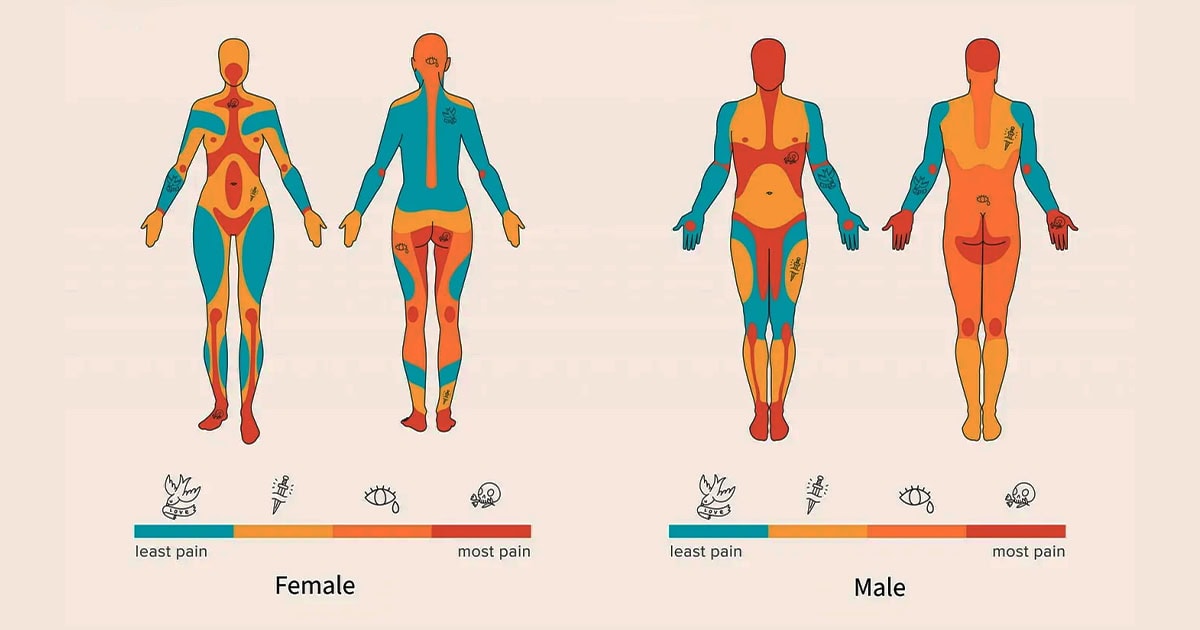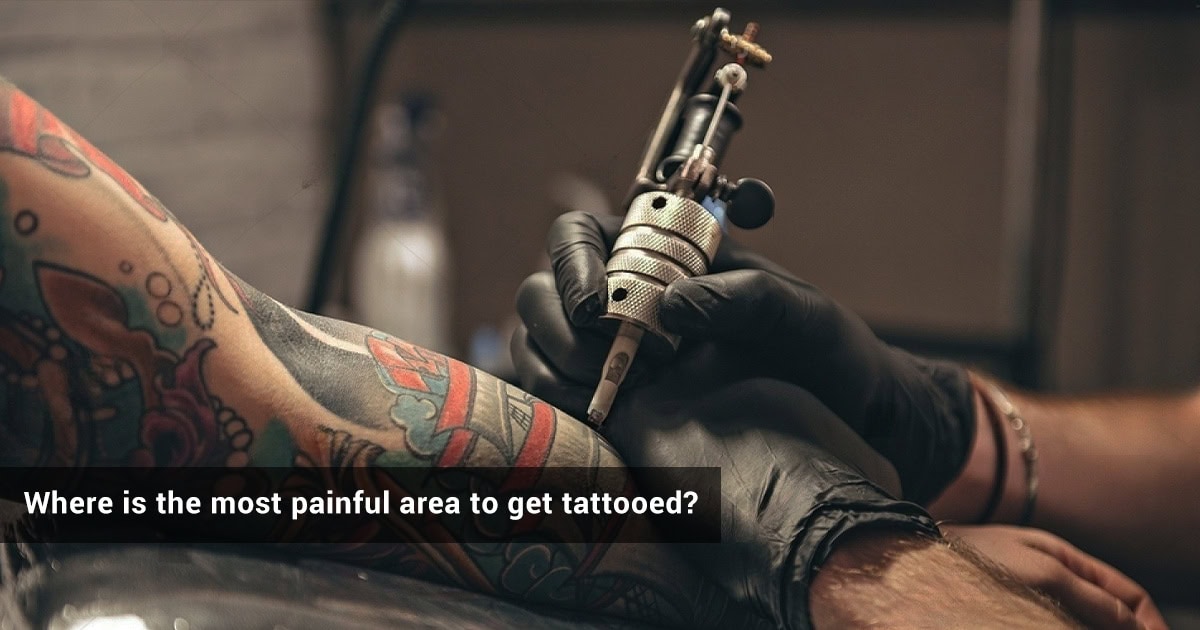Tattoo World
Where is the most painful area to get tattooed?
Tattooing involves the insertion of ink into the dermis layer of the skin using needles. This process can cause varying levels of pain depending on several factors, including the individual’s pain tolerance, the body area being tattooed, and the duration of the tattooing session. Here’s a detailed breakdown of the pain experience in different body areas:
The most painful area to get tattooed

Very high
1. Head/Face
- Pain Level: Very High
- Explanation: The skin on the face and head is very thin and close to the bone, making the process more painful. The face also has a high concentration of nerve endings, which increases sensitivity.
2. Chest
- Pain Level: Very High
- Explanation: The chest has thin skin, especially over the sternum and ribs. The proximity to bone and the movement caused by breathing can make tattooing here very painful.
3. Stomach
- Pain Level: Very High
- Explanation: The stomach is a soft and sensitive area with thin skin and less muscle protection. The pain can be intense due to the sensitivity of the region.
4. Ribs/Sides
- Pain Level: Very High
- Explanation: The ribs are covered with thin skin and little fat or muscle, making them extremely painful to tattoo. The ribcage also moves with breathing, which can exacerbate the pain.
High
5. Neck
- Pain Level: High
- Explanation: The neck has thin skin and is a highly sensitive area due to the presence of many nerve endings and muscles. The pain is often described as sharp and intense.
6. Lower Back
- Pain Level: High
- Explanation: While the lower back has some muscle and fat, tattooing close to the spine can be quite painful. The lower back is also a less cushioned area compared to the upper back.
7. Hands/Fingers
- Pain Level: High
- Explanation: The skin on the hands and fingers is thin with little cushioning. There are also many nerve endings in this area, making it highly sensitive and painful.
8. Hips
- Pain Level: High
- Explanation: The hips have a combination of bone, muscle, and fat. The skin is relatively thin, and the area can be sensitive, especially over the hip bones.
9. Knee
- Pain Level: High
- Explanation: The knee area, particularly over the kneecap, has thin skin and is close to bone, making it a painful spot to tattoo. The movement of the joint can also add to the discomfort.
10. Ankles/Feet
- Pain Level: High
- Explanation: The skin on the ankles and feet is thin with little cushioning. These areas are also densely packed with nerve endings, making them very sensitive and painful to tattoo.
Moderate
11. Upper Back
- Pain Level: Moderate
- Explanation: The upper back has more muscle and fat, which can cushion the impact of the needle. However, tattooing over the spine or shoulder blades can be more painful due to the proximity to bone.
12. Thigh
- Pain Level: Moderate
- Explanation: The thigh has a significant amount of muscle and fat, which helps cushion the needle’s impact. However, the inner thigh can be more painful due to thinner skin and sensitivity.
13. Lower Leg
- Pain Level: Moderate
- Explanation: The lower leg has muscle and some fat, but areas like the shin are close to bone and can be quite painful. The calf is generally less painful due to more muscle.
Low
14. Upper Arm
- Pain Level: Low
- Explanation: The upper arm has a good amount of muscle and fat, providing cushioning. It is one of the least painful areas to get tattooed.
15. Forearm
- Pain Level: Low
- Explanation: Similar to the upper arm, the forearm has adequate muscle and fat. The pain is usually manageable and less intense.
Comparison between male and female
Pain levels by body area for female tattooing
| Body Area | Pain Level |
|---|---|
| Head/Face | Very High |
| Neck | High |
| Upper Back | Moderate |
| Lower Back | High |
| Chest | Very High |
| Stomach | Very High |
| Upper Arm | Low |
| Forearm | Low |
| Hands/Fingers | High |
| Ribs/Sides | Very High |
| Hips | High |
| Thigh | Moderate |
| Knee | High |
| Lower Leg | Moderate |
| Ankles/Feet | High |
Pain levels by body area for male tattooing
| Body Area | Pain Level |
|---|---|
| Head/Face | Very High |
| Neck | High |
| Upper Back | Moderate |
| Lower Back | High |
| Chest | High |
| Stomach | Very High |
| Upper Arm | Low |
| Forearm | Low |
| Hands/Fingers | High |
| Ribs/Sides | Very High |
| Hips | High |
| Thigh | Moderate |
| Knee | High |
| Lower Leg | Moderate |
| Ankles/Feet | High |
Factors influencing tattoo pain
- Individual Pain Tolerance: Varies greatly among individuals. Some people have higher pain thresholds than others.
- Tattoo Artist’s Technique: Experienced artists often have techniques that can minimize pain.
- Tattoo Duration: Longer sessions can lead to increased pain due to prolonged irritation of the skin.
- Needle Size and Speed: Different needles and machine settings can influence the level of pain experienced.
Tips for managing tattoo pain
- Stay Hydrated: Drinking plenty of water can help keep the skin supple.
- Avoid Alcohol and Caffeine: These can thin the blood and increase sensitivity.
- Eat a Good Meal: Having a meal before the session can help maintain energy levels.
- Take Breaks: If the pain becomes too intense, ask for short breaks during the session.
- Use Numbing Creams: Some over-the-counter creams can numb the skin temporarily, though they should be used under the guidance of the tattoo artist.
Managing Tattoo Pain with TKTX Numbing Cream
For those concerned about pain, TKTX Numbing Cream offers an effective solution. Its unique formulation, containing lidocaine, prilocaine, and epinephrine, is designed to penetrate deeply and provide long-lasting numbing. TKTX is available in various formulas, each indicated by a color to denote its strength, making it easier to choose the right one for your pain management needs. The green TKTX cream, in particular, is noted for its high effectiveness.
Choosing the appropriate TKTX product involves considering your pain tolerance and the specific location of your tattoo. It’s also crucial to consult with your tattoo artist before applying any numbing cream to ensure it won’t affect the tattoo’s outcome. Following the product’s application instructions will maximize its efficacy.
Understanding these factors and preparing accordingly can help manage the pain and make the tattooing experience more bearable.

